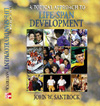 |  Life-Span Development: A Topical Approach John W. Santrock
Socioemotional Processes and Development Moral Development, Values, and Religion
Learning Objectives1.Understand how moral development involves thoughts, feelings, and behaviors regarding right and wrong and consists of intrapersonal and interpersonal dimensions. |
 |  |  | 2.Compare Piaget's simpler theory of moral development with Kohlberg's provocative theory of moral reasoning, looking specifically at:
- Piaget's heteronomous and autonomous stages for younger and older children
- Kohlberg's three levels/six stages, progressing from preconventional, to conventional, to postconventional levels, noting their relationship to age
- The various influences on Kohlberg's stages, including cognitive development, imitation and cognitive conflict, peer relations, and perspective taking
- Criticisms of Kohlberg's theory, especially by Gilligan, who advocates a stronger care perspective
- The distinction between moral reasoning and social conventional reasoning
|
 |  |  | 3.Contrast moral behavior from the behaviorists' argument that it is determined by the processes of reinforcement, punishment, and imitation, stressing situational variability with social cognitive theory, which emphasizes a distinction between moral competence and performance. |
 |  |  | 4.Discuss moral feelings in the context of psychoanalytic theory and Freud's description of the superego as the moral branch of personality, noting the importance of empathy and its developmental changes, then address the contemporary perspective that says both positive and negative feelings contribute to moral development. |
 |  |  | 5.Describe altruism as an unselfish interest in helping someone, although reciprocity and exchange are often involved, noting Damon's developmental sequences of altruism. |
 |  |  | 6.Explain how parenting affects moral development, addressing issues of love withdrawal, power assertion, and induction as discipline techniques, noting that induction is most likely to be linked with positive moral development (at least in middle-SES children), then discuss the parenting strategies that can advance moral development. |
 |  |  | 7.Explore the hidden curriculum in moral education initially described by Dewey, noting the contemporary approaches to moral education that include character education, values education, and cognitive moral education, and discuss the place of service learning in this regard. |
 |  |  | 8.Consider conduct disorder, which refers to age-inappropriate actions and attitudes that violate family expectations, society's norms, and the personal or property rights of others, and juvenile delinquency, which refers to a broad range of behaviors from socially unacceptable behavior to status offenses to criminal behavior. |
 |  |  | 9.Describe values, which are beliefs and attitudes about the way people think things should be, and how over the last two decades young adults have shown an increased interest in personal well-being and a decreased interest in the welfare of others. |
 |  |  | 10.Discuss the developmental aspects of religion throughout the life span, noting:- adolescence as a special juncture in religious development
- how Piaget's theory provides a cognitive background for understanding developmental changes in religion
- Fowler's six-stage life-span development view
- the importance of religion in the lives of people in the United States and around the world
- gender differences with respect to interest in religion
- how adults tend to examine life's meaning as they age and face their own deaths
|
|



 2002 McGraw-Hill Higher Education
2002 McGraw-Hill Higher Education